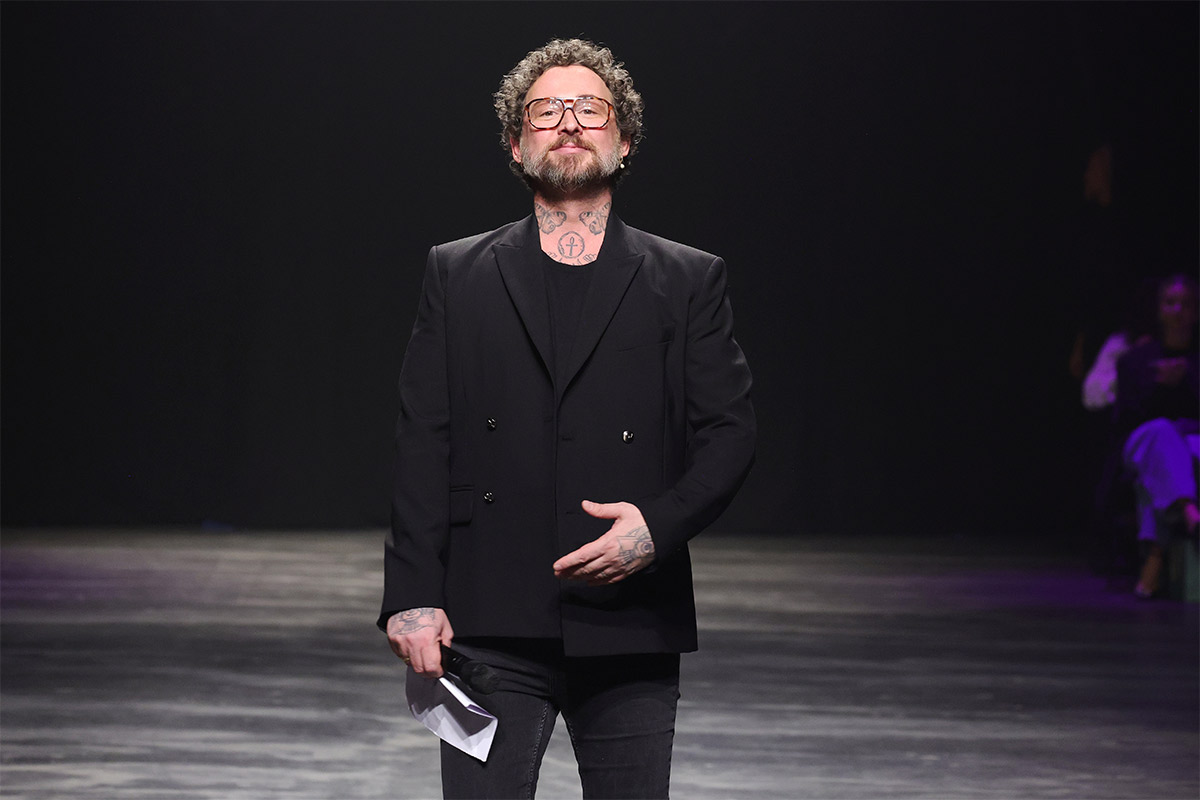Unfortunately, we couldn’t see all W.E4.FD shows this time. Some events simply run in parallel, and we also enjoyed getting to know new brands, designers, and venues. Therefore, we missed the Fashion Week shows by Danny Reinke and Kilian Kerner in the Veri Music Hall this time. But of course, we didn’t miss the show of Marcel Ostertag.
THE DESIGNER MARCEL OSTERTAG
Marcel has had an exciting journey that has left him very grounded. Today, his appearance is very likable. Not only but also because he has appeared, for example, on the Fashion Week stage in summer in a baggy shirt, shorts, and flip-flops. This was very relaxing, and inspiring for all.
Marcel looks into the depths and beyond the horizon. He is a role model for many. Be it through his creations or his projects. And it was once again worth seeing and completely wearable at this Fashion Week.
Similar to his three friends, Marcel Ostertag also caresses the female body with materials that are sometimes very soft and sometimes very raw. In Denmark, this is called a rock ballerina.
A concept that is even suitable for everyday use, because by adding a few accessories, a look can be transformed from a cool daytime look to a chic evening outfit.
MARCEL OSTERTAG’S FLOWERS IN THE DARK
It’s unbelievable how many pieces his collections contain each season and – associated with this – how much creativity they contain. The theme of this collection was “Flowers in the Dark”. The romantic styles brought light and warmth into the darkness of our time. Blossoming buds promised a hopeful new beginning.
Marcel Ostertag also initiated the sustainability contest together with Rebekka Ruétz, Kilian Kerner, and Danny Reinke. With this competition, the top designers support young talents. In addition, they motivate them to think outside the box. As the name suggests, the competition is about developing ideas to make fashion more sustainable while keeping the reprocessing and use process in mind. The winner of this Fashion Week was Alexandra Bobrowski.
THE PROTEST
It was, therefore, very surprising that two young women used the stage to point out injustices in the fashion industry.
Many actions of this kind can now only be viewed as inappropriate. Many people work on such an event with passion and from the bottom of their hearts. Thus, a lot of effort goes into a show like this, which – whether you like it or not – should be treated with respect.
There are certainly many black sheep, especially among the large and popular fashion chains. Of course, human rights and animal protection are certainly being ignored in many places. Today we must talk about a modern slave market. But no one will save the world with blanket statements like “wool kills.”
They should also question what they are wearing on the body, feet, and legs or how the writing got onto the paper and how it got into the foil. Therefore, they could ask themselves how all of this has to be brought into line with their accusation.
We have all done a lot of wrong things since industrialization. Unfortunately, we are still doing so. It is time to seek solutions through constructive dialogues to correct the mistakes of the past and to avoid new ones in the future. There is still time.
THE ALTERNATIVE
We will not make the world a better place for everyone with bigotry, radicalism, or excessive actions – such as spraying paint on the Brandenburg Gate, one of Germany’s most important monuments. The will to change should be reflected in not pointing the finger at others, but simply doing things better yourself!
The first step is to change people’s consciousness. This is best achieved through joint education, not through actions like at Fashion Week.
Showing a personal path is also an option. It doesn’t matter whether this is the right one, as long as the idea inspires others to find their way.
And the best way to protect the environment and human rights is high or slow fashion, be it from Marcel Ostertag or other designers.
We have already described the fact that Fashion Week deals intensively with the topic of sustainability. If you want to use these days to raise awareness, the tip is to form a team, find partners, develop an event, invite the media, politicians, celebrities, etc., and ensure the appropriate reach. In this way, an important message can be spread into the world.
Of course, there are many other ways, as we have also been using the Internet for 15 years to communicate sustainable and social issues at an international level in an easy-to-understand way. Not easy, of course. A challenge, and always a mission.
Text: Marco Kokkot
Photos: Andreas Rentz/Getty Images











